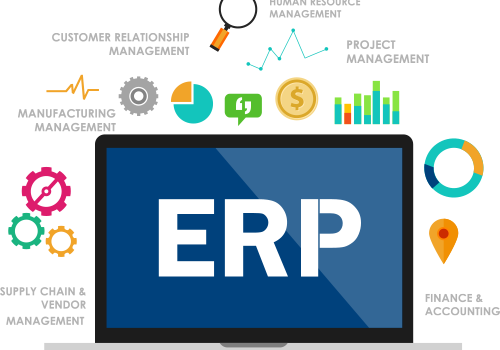A complete 360 degrees analysis on ERP software industry
An Enterprise Resource Planning or ERP tool is a business management software that aims to create lean, efficient, automated, and integrated solutions for businesses. An ERP system allows organizations and its stakeholders to gather, store, communicate, and manage data across all workflows of the enterprise. The end goal is to encourage strategic decision-making through the proper integration of business data, functions, and resources.

One of the pivotal features of an ERP is its ability to integrate information from all aspects of a business into a central database system to facilitate data sharing and management in real-time. So, once you feed data into the ERP software, it gets updated throughout the entire business system, thereby allowing all users to access the updated information. This is one of the fundamental reasons behind the popularity and increasing adoption of ERP softwares in the industry. Initially, ERP software vendors targeted large corporates and enterprises. However, today, ERP software has found application even in small to midsize (SMB) companies – thanks to the growing importance and contributions of SMBs in the global economy.
ERP Software: Global Market Size
According to recent ERP software industry analysis, by 2020, the global ERP market is predicted to hit the $42 billion mark, growing at a steady CAGR of 7.3%. By 2026, the ERP software market will grow at a CAGR of 9% to reach $74.20 billion.
Thanks to the feasibility of ERP solutions, today, the ERP market includes businesses of all sizes. ERP solutions help companies to automate routine tasks, boost operational efficiency, and improve the transparency of business operations. While large corporations invest in ERP solutions due to regulatory compliance, centralization, and most importantly, globalization, SMBs leverage ERP solutions to meet emerging customer requirements. The key drivers of ERP solutions are:
- High penetration of cloud computing and cloud-based deployment models across all industries.
- The acquisition of small software companies by large ERP vendors.
- Increasing competition in the global market.
- The growth of newly emerging markets.
- Rapid economic growth.
However, the high initial installation costs, the increasing accessibility of open-source applications, cut-throat competition within the market, and recession are the biggest challenges faced by the ERP market.
ERP Software Market: Regional Outlook, Major Proponents, Segment Overview, and Future Scope
Although Europe and North America lead the ERP market (thanks to the large-scale implementation of software solutions in businesses), possibilities of emerging markets for ERP solutions have been realized in countries like Japan, South Korea, Malaysia, and Australia. Also, Asia Pacific has now emerged as the fastest-growing ERP market due to the rapid growth of manufacturing and semiconductor industries in the emerging countries of the region and the entry of global companies in the Asia-Pacific market.
Two of the biggest players in the ERP market are SAP and Oracle. While SAP is investing heavily in line-of-business SaaS applications to cater to Sales and Human Resources, Oracle is pushing its next-gen Fusion Applications that can both function as SaaS and can also run on-premise. Other companies that have joined the ERP bandwagon include Infor, Sage Group, Microsoft Corporation, IBM Corporation, TOTVS, Unit4, NetSuite Inc., Focus Softnet, QAD Inc., Epicor, JD Edwards, Ventyx, and WorkForce Software, to name a few. All the top names in the ERP market use a combination of strategies to remain relevant in the competitive market. These strategies include partnerships, collaborations and mergers, acquisitions, and product launches.
At present, the ERP software industry analysis is conducted based on a handful of industries including BFSI, Healthcare, Telecom, Automotive, Manufacturing & Services, Retail, Pharmaceutical, Government utilities, and Aerospace and Defense. It can be further fragmented according to type and size of the industry. For instance, there are large corporations requiring both scalable and global functionalities; then there are upper-tier mid-market companies requiring multinational but less scalable functionalities; lower-tier mid-market companies requiring multinational functionalities with minimal scalability, and small businesses based out of a particular location requiring only location-specific and standardized packages. The two most widely used ERP software deployment models are cloud and on-premise. Although presently, the on-premise model holds a larger market share, in the future, cloud-based ERP solutions are expected to escalate rapidly. This is primarily because cloud-based ERP solutions have low initial implementation cost, plus they offer highly flexible services.
Since the demand for telecom services has increased exponentially in the past few years, this industry holds tremendous potential for ERP software solutions. Increasing customer awareness is pushing the telecom industry to incorporate automated ERP solutions to reach out and connect with more consumers in real-time. Customers now demand industry-specific products/services. Furthermore, to better handle support functions like sales, order management, receivables management, convergent billing, and customer-brand relationship management, telecom companies are adopting ERP software solutions. Similarly, the healthcare industry also poses an attractive market for ERP software solutions. Patients now demand real-time disease diagnosis and monitoring, consolidation of individual patient healthcare data, and speedy delivery of healthcare services. ERP solutions can help healthcare providers to achieve all the services mentioned above.
ERP software solutions allow companies to monitor, track, integrate, and continuously update the business processes database via a central database management platform. In simple words, ERP facilitates seamless and smooth integration of business functions and workflows, thereby enhancing the overall business productivity. As more companies adopt cutting-edge ERP solutions (for instance cloud ERP), it will further drive other players in the industry to choose ERP solutions as well – businesses now have to either embrace the change or fade away in the ever-changing business ecosystem.
















